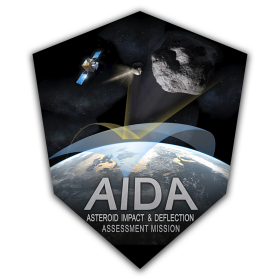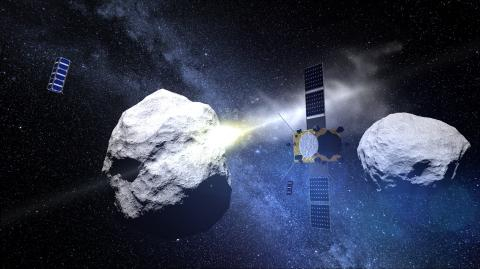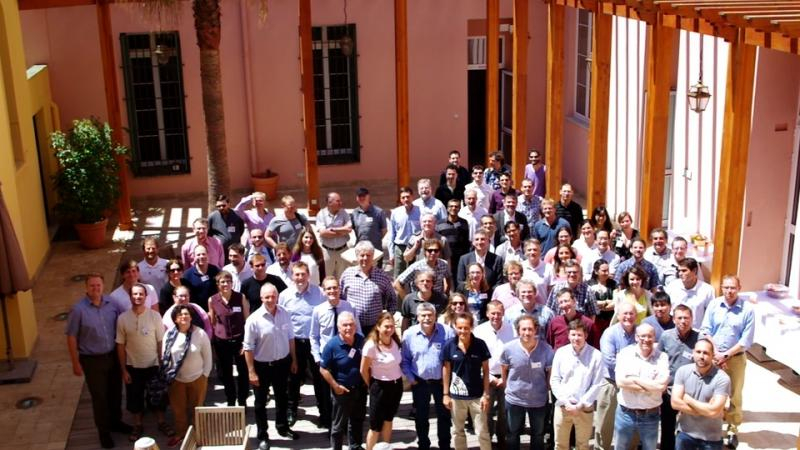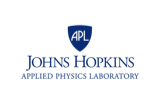June 1-3, 2016 Hôtel Saint-Paul Nice, France
PROGRAM WORKSHOP QUESTIONS ORGANIZERS
The second International Asteroid Impact Deflection Assessment (AIDA) Workshop, which will serve as a Technical Interchange Meeting, will be held 1-3 June 2016 at the Conference center of the Hôtel Saint-Paul in Nice, France. The first workshop took place at the Applied Physics Laboratory (APL) of the John Hopkins University (JHU) in Laurel (MD, USA) in October 2014.



AIDA is a technology demonstration of the kinetic impactor concept. It is composed of the DART (Double Asteroid Redirection Test) spacecraft under Phase A at NASA and the AIM (Asteroid Impact Mission) spacecraft under Phase A/B1 at ESA, until late 2016.The combination of both spacecrafts is referred to as AIDA. The target characterization (AIM, including for the first time the direct investigation an asteroid internal structure) and impact (DART, first detailed large scale impact experiment on an asteroid) are planed for 2022.
The workshop offers a forum for the community to keep abreast with the advances of the AIM and DART studies. As such these two concepts will be presented, in terms of design, payloads and objectives, followed by presentations and discussions related to the science and planetary defense aspects of AIDA. These will include the current knowledge of the Didymos binary Near-Earth asteroid, the target of AIDA, and a more general discussion on binary systems, regolith characteristics and mechanics, internal structures of asteroids, impact observing strategies, additional science opportunities during an impact demonstration and associated payloads, impact modeling and momentum transfer of an artificial projectile, ejecta dynamics, etc. .
For any questions please contact Patrick Michel and Andy Cheng at the following email addresses:
michelp at oca.eu
andy.cheng at jhuapl.edu
Information about AIDA can be found on the following web sites:
ESA AIM website
AIDA Team website




Program AIDA workshop Version of May 9, 2016
The program and speakers have been fixed. Note that the sessions with oral presentations contain only solicited talks, but the program is organized such that there will be ample time for discussions and working sessions, allowing all workshop participants to contribute actively, which is greatly encouraged. The program is defined on the basis of the four AIDA working group activities (click here to see the working group list and chairs).
Wednesday June 1, 2016
9:00-10:30 am: Introduction
Workshop Opening, logistics (P. Michel)
Introduction by the Director of the Observatoire de la Côte d’Azur (OCA) (T. Lanz)
The AIM component of the AIDA mission (ESA)
The DART component of the AIDA mission (NASA, APL/JHU)
10:30-11:00 am: coffee break
11:00-12:30 pm: Working Group 1 (Impact modeling)
Introduction on benchmarking exercize (code comparisons)
Presentations by members of the benchmarking project:
- RAGE code (G. Gisler)
- iSALE code (K. Wünneman, G. Collins et al.)
- ASPH code (M. Owen) - « ASPH modeling of damage and cratering »
- CTH Coce (E. Rainey)
Summary of benchmarking campaign, current work, next steps (A. Stickle)
12:30-2:00 pm: working lunch
2:00-3:30 pm: Working Group 1 (impact modeling, ejecta fate)
Large-scale impact models for support of DART:
- M. Bruck Syal: « Modeling the DART impact with adaptative SPH »
- G. Gisler, J.M. Ferguson, C.S. Plesk, R.P. Weaver: « RAGE calculations of the impact of solid metal projectiles into rocky asteroids »
- A.M. Stickle, E. Rainey: « Modeling studies in support of the DART mission »
Comprehensive ejecta evolution models
- Observatoire de la Côte d’Azur activities (S. Schwartz, Y. Yu, P. Michel)
- University of Maryland activities (D. Hamilton)
- JPL activities (E. Fahnestock)
3:30-4:00 pm coffee break
4:00 pm-6:00 pm: Discussion on specific issues/round table
- Overview on dust production and evolution (J.B. Vincent)
- Overview of the effects of porosity on ejecta properties (discussion leader: G. Collins).
- Quantifying seismic activity and potential implications on regolith lofting (N. Murdoch, E. Asphaug)
- Open discussion on issues involving low-speed ejecta, including lofting of regolith due to seismic energy propagation (Chair: S. Schwartz)
7:00 pm-: Finger food/dîner cocktail on site
Thursday June 2, 2016
9:00-10:30 am: Working Group 3 (dynamics and physical properties of AIDA’s target: Didymos)
- Introduction by Working Group 3 Chairs (D.C. Richardson, A. Campo Bagatin, K. Tsiganis)
- Dynamics of Didymos (K. Tsiganis)
- Univ. of Alicante activities (A. Campo Bagatin)
- Drop tower experiments and seismology (N. Murdoch, E. Asphaug)
10:30 am-11:00 am: coffee Break
11:00-13:00:
- Summary of work by non-attending team members (WG3 chairs)
- IMCCE activities (S. Eggl)
- NASA Goddard activities (B. Barbee)
- Discussion
13:00-2:30 pm: working lunch
2:30-4:00 pm: Working Group 3 (dynamics and physical properties of AIDA’s target: Didymos)
- SWRI activities (K. Walsh)
- Univ. of Maryland activities (D.C. Richardson et al.)
- Purdue Univ. activities (T. Hirabayashi)
- DLR activities (J. Biele, TBC)
4:00-4:30 pm: coffee break
4:30-5:30 pm:
Discussion/round table on next steps regarding Working Group 3 activities.
5:30-6:30 pm: Presentations of the 5 CubeSats concepts on AIM
- AGEX (O. Karatekinà
- ASPECT (M. Granvik)
- DustCube (F. Aguado)
- CUBATA (D. D. Escorial/M. Grenanin)
- PALS (J.-E. Wahlund)
7:30-: Drink and Diner at the Negresco Hotel
Friday June 3, 2016
9:30-10:30 am: Space Agency presentations
ESA perspectives (F. Ongaro)
NASA perspectives (R. Landis, T. Statler)
Lagrange Laboratory of OCA (P. Stee)
OCA (T. Lanz)
10:30-11:00 am: coffee break
11:00-12:30: Working Group 2 (Remote observations)
- Summary of radar observations and Didymos’ model (S. Naidu)
- Summary of light curve observations and Didymos' model (P. Pravec, P. Scheirich)
- Deflection estimation for the stand-alone DART mission (S. Chesley)
- Discussion on the preparation of remote observations of Didymos in the coming years: when will optical observations refine knowledge of the Didymoon ephemeris enough to constrain targeting of the DART impact? (discussion led by P. Pravec)
- Organization of observational campaigns in 2022: What are the expected results of observing the actual impact epoch in optical? radar? infrared?
12:30-2:00 pm: working lunch
2:00-3:30 pm: Working Group 4 (Science Proximity Operations)
- Camera system for the AIM mission (H. Sierks)
- Radar systems for the AIM mission (A. Hérique)
- Proposal for joint determination of Didymos/Didymoon orbit, gravity, shape and rotation from tracking data, imaging and ranging by the AIDA mission (J. Oberst)
- Measurement principles of β-factor estimation for asteroid impact missions (S. Delchambre)
- Flight Dynamics in a binary asteroid system (D. Scheeres)
3:30-4:00 pm: coffee break
4:00 pm-5:45 pm: Round table on orbit determination and radio science
Speakers: J. Bellerose, P. Rosenblatt, M. Zannoni
5:45-6:00 pm: Conclusions, End of workshop
Set of questions to be discussed during the AIDA Workshop 2016
Working Group 1:
What are the differences in code predictions for DART impact outcomes?
What causes these differences? How might specific code predictions be confronted by observation?
What is the range of beta predictions?
How sensitive are impact results to various target’s properties (shape, impact site, etc)?
What is the likelihood of a momentum transfer that is too small to measure by ground observers? To measure by AIM?
What is the likelihood of disruption?
Is there reason to bias the DART impact aim point away from the center of the figure? What about targeting center of light?
How much impact energy goes into rotation?
How will the ejecta evolve with time?
Working Group 2:
When will optical observations refine knowledge of the Didymoon ephemeris enough to constrain targeting of the DART impact?
What are the expected results of observing the actual impact epoch in optical? radar? infrared?
Working Group 3:
What observables constrain the porosity and the strength of Didymoon?
How well will these properties be constrained by AIDA?
What is the range of predictions for changes in the target’s rotation state from the DART impact?
How well can AIDA be expected to constrain internal structure (that is, spatially map physical properties)?
How will the tides on the primary from the secondary change as a result of its changed orbit? Could there be observable effects on the
primary surface? (E.g., "landslides", or "tidal saltation"?)
Will the changed orbit of the secondary be stable? How will it evolve during months, years, and on longer time scales after the impact?
What would be a final fate of the secondary?
What is the range of predictions concerning the extent of surface acceleration/modification from the DART impact?
Working Group 4:
Where should MASCOT be during DART impact?
Where should AIM be during the DART impact?
When can AIM resume close-in operations and observations?
Organizing Committee
The Scientific Organizing Committee (SOC) consists of the team leaders and Working Group Chairs:
Andy Cheng (DART Science Team lead)
Patrick Michel (AIM Science Team lead)
Michael Kueppers (AIM ESA Project Scientist)
Angela Stickle (Co-Chair, Working Group 1 on impact modeling)
Paul Miller (Co-Chair, Working Group 1 on impact modeling)
Stephen R. Schwartz (Co-Chair, Working Group 1 on impact modeling)
Petr Pravec (Co-Chair, Working Group 2 on ground based observations)
Andy Rivkin (Co-Chair, Working Group 2 on ground based observations)
Derek C. Richardson (Co-Chair, Working Group 3 on dynamical modeling and physical properties)
Adriano Campo Bagatin (Co-Chair, Working Group 3 on dynamical modeling and physical properties)
Kleomenis Tsiganis (Co-Chair, Working Group 3 on dynamical modeling and physical properties)
Stephan Ulamec (Co-Chair, Working Group 4 on science proximity operations)
Olivier Barnouin (Co-Chair, Working Group 4 on science proximity operations)
We acknowledge the support of the members of the AIM and DART teams.
The Local Organizer is Patrick Michel.
For more information or any questions please contact Patrick Michel and Andy Cheng at the following email addresses:
michelp at oca.eu
andy.cheng at jhuapl.edu








